Related Research Articles
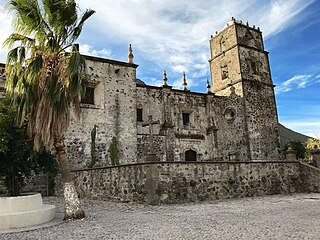
Misión San Francisco Javier de Viggé-Biaundó was a Spanish mission in San Javier, Baja California Sur, on the Baja California peninsula. It was built during the colonial era of the Viceroyalty of New Spain. The site is in present-day Loreto Municipality of Baja California Sur state. The mission was located at 25°51′38″N111°32′37″W. San Francisco Javier mission was founded by Jesuits of the Roman Catholic church in 1699 and closed in 1817.
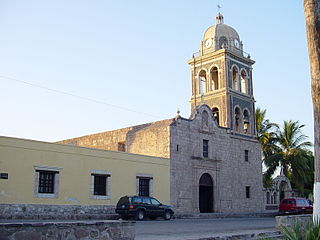
Misión de Nuestra Señora de Loreto Conchó, or Mission Loreto, was founded on October 25, 1697, at the Monqui Native American (Indian) settlement of Conchó in the city of Loreto, Baja California Sur, Mexico. Established by the Catholic Church's Jesuit missionary Juan María de Salvatierra, Loreto was the first successful mission and Spanish town in Baja California.
Sigismundo Taraval (1700–1763) was a pioneering Jesuit missionary in Baja California who wrote important historical accounts of the peninsula.
Santiago is a small town in Los Cabos Municipality in Baja California Sur, Mexico, located on Mexico's Highway 1, about an hour's drive north of San José del Cabo. Like Todos Santos it is almost directly on top of the Tropic of Cancer.

The Spanish missions in Baja California were a large number of religious outposts established by Catholic religious orders, the Jesuits, the Franciscans and the Dominicans, between 1683 and 1834 to spread the Christian doctrine among the Indigenous peoples living on the Baja California peninsula. The missions gave Spain a valuable toehold in the frontier land, and introduced European livestock, fruits, vegetables, and industry into the region. Indigenous peoples were severely impacted by the introduction of European diseases such as smallpox and measles and by 1800 their numbers were a fraction of what they had been before the arrival of the Spanish.

The Guaycura were a native people of Baja California Sur, Mexico, occupying an area extending south from near Loreto to Todos Santos They contested the area around La Paz with the Pericú. The Guaycura were nomadic hunter-gatherers. They are distinguished by a language unrelated to any other Native American language, indicating in the opinion of some linguists that their ancestry in Baja California dates back thousands of years.
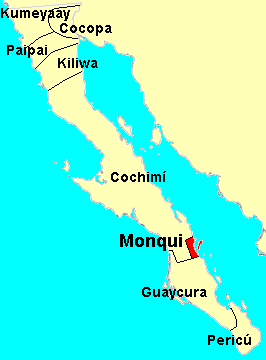
The Monqui were indigenous peoples of Mexico, who lived in the vicinity of Loreto, Baja California Sur, Mexico, at the time of Spanish contact. Monqui territory included about 65 kilometres (40 mi) of coast along the Gulf of California and extended a few kilometers inland to where the Cochimi people lived.
Francisco María Piccolo, S.J., (1654–1729) was one of the first Jesuit missionaries in Baja California Sur, New Spain, now Mexico. His letters and reports are important sources for the ethnography and early history of the peninsula.
Miguel del Barco was a Jesuit missionary in Baja California, Mexico and wrote major contributions to the peninsula's history and ethnography.

Misión Santa Rosa de las Palmas, also known as Todos Santos Mission, was founded by the Roman Catholic Jesuits in 1733 and dedicated to Saint Rose of Lima. After 1748, the mission was known as Nuestra Señora del Pilar de la Paz. The mission was the first European settlement at the site of what is now the city of Todos Santos, Baja California Sur.
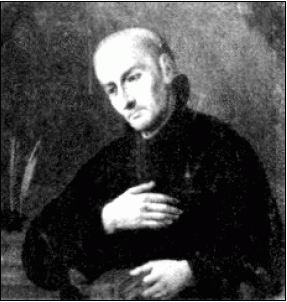
Juan de Ugarte, S.J., (1662–1730) was a Jesuit missionary and explorer in Baja California Sur, New Spain, and the successor to Juan María de Salvatierra as head of the peninsula's missions.
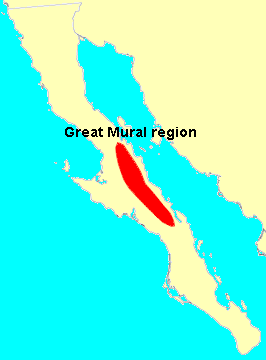
Great Mural Rock Art consists of prehistoric paintings of humans and other animals, often larger than life-size, on the walls and ceilings of natural rock shelters in the mountains of northern Baja California Sur and southern Baja California, Mexico. This group of monuments comprises the site Rock Paintings of Sierra de San Francisco, which is included on the UNESCO World Heritage List.

The Californias, occasionally known as The Three Californias or Two Californias, are a region of North America spanning the United States and Mexico, consisting of the U.S. state of California and the Mexican states of Baja California and Baja California Sur. Historically, the term Californias was used to define the vast northwestern region of Spanish America, as the Province of the Californias, and later as a collective term for Alta California and the Baja California Peninsula.

The Rock Paintings of Sierra de San Francisco are prehistoric rock art pictographs found in the Sierra de San Francisco mountain range in Mulegé Municipality of the northern region of Baja California Sur state, in Mexico.
Pedro Antonio Amador was a Spanish sergeant of the Presidio of Loreto who was present at the establishments of the pueblos of San Diego and Monterey in Alta California.
Ignacio Maria Napoli was an Italian Jesuit missionary to the Baja California peninsula. In 1723, he founded the Misión de Santiago de los Coras Aiñiní, which was located southwest of Bahía las Palmas. Napoli arrived in the Cora area of Aiñiní around 1721. Replaced by Lorenzo Carranco, he was transferred to Sinaloa or Sonora by 1726. In 1736, he was directing the Yaqui missions at Huirivis, Pótam, and Rahum.

Lorenzo José Carranco was a Jesuit missionary.
José Mariano Rotea was a Jesuit missionary on the Baja California peninsula who played a key role in the rediscovery of the peninsula's prehistoric Great Murals rock art.
The Sierra de San Borja, also known as Sierra La Libertad is a mountain range on the Baja California Peninsula of Mexico. It is one of the Peninsular Ranges which form the backbone of Baja California. The Sierra de San Borja is located between 28° North latitude and 29° North latitude. The highest point of the Sierra is Cerro La Sandia, 1,775 metres (5,823 ft) in elevation located at 28°24′25″N113°26′18″W.

Province of Las Californias was a Spanish Empire province in the northwestern region of New Spain. Its territory consisted of the entire U.S. state of California, a vast portion of Nevada, Utah, Arizona, Wyoming, Colorado and New Mexico, and the Mexican states of Baja California and Baja California Sur.
References
- ↑ Karen Kenyon, "Tracking the Hispanic Roots of California", Los Angeles Times , April 12, 1987.
- ↑ "Rock Paintings of the Sierra de San Francisco". World Heritage Convention, UNESCO, whc.unesco.org. Retrieved February 20, 2023.
{{cite web}}: CS1 maint: url-status (link) - ↑ Watchman, Alan; de la Luz Gutierrez, Maria; Hernandez Llosas, Maria Isabel (November 2022). "Variation and Age of the Gran Mural Rock Paintings, Baja California Sur, Mexico". Rock Art Research Journal. 39 (1).
- ↑ Collins, Craig K. (February 7, 2023). "The Time of the Painters". Hidden Compass Magazine. Retrieved February 20, 2023.
- ↑ Mark Rose, "Cave Paintings of Baja California", Archeology , December 30, 1998.
- ↑ John Roach (July 17, 2003). "Baja California Rock Art Dated to 7,500 Years Ago". National Geographic News . Archived from the original on November 10, 2005.
- ↑ Renee Tawa, "Parker wins top prize for fiction", Los Angeles Times , October 27, 2003.
- ↑ James D. Reilly (January 1, 1999). "Antigua California: Mission and Colony on the Peninsular Frontier, 1697-1768". The Catholic Historical Review (Book Review). 85 (1): 137–138. JSTOR 25025457.
- ↑ Caroline Bancroft History Prize Archived 2008-12-26 at the Wayback Machine , Denver Public Library (accessed 2012-06-20).